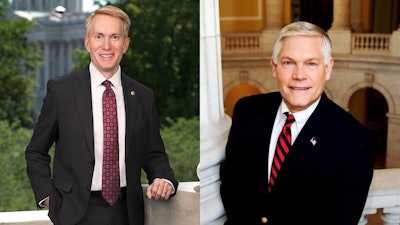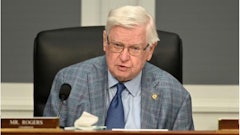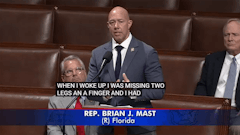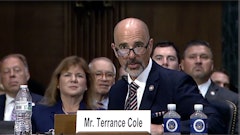
As the 60-day public comment period on a proposed rule to reschedule cannabis nears an end, 25 U.S. lawmakers are making their case to halt the process.
Sen. James Lankford, R-Okla., and Rep. Pete Sessions, R-Texas, released a public letter they sent to Attorney General Merrick Garland on July 10. The bicameral letter, signed by nine senators and 16 House members—all Republicans—condemns the Biden administration’s active process to reclassify cannabis from a Schedule I to Schedule III drug under the Controlled Substances Act (CSA).
Garland, a Biden cabinet member who heads the Department of Justice (DOJ), signed a 92-page notice of proposed rulemaking on May 16. The notice was published in the Federal Register on May 21, igniting the 60-day comment period. Comments must be submitted electronically or postmarked on or before July 22.
The letter from Lankford and Sessions suggests that the Department of Health and Human Services’ (HHS) recommendation to the Drug Enforcement Administration (DEA) in August 2023—that cannabis should be a Schedule III drug—was “based on politics, not science,” according to a press release from Sessions’ office.
Specifically, the HHS determined that cannabis has “currently accepted medical use” in the U.S., and therefore, it does not belong in Schedule I.
“The decision to disregard public safety and medical concerns to reclassify marijuana is strictly political,” Sessions said in the release. “This egregious proposed rule fails to provide sufficient science and data in support. Senator Lankford and I are leading the charge in raising the alarm from Congress.”
Prohibitionist group Smart Approaches to Marijuana (SAM) posted the letter on its website. Sessions’ press release quoted SAM President Kevin Sabet.
“The recent HHS decision gets ahead of the science and takes ‘big marijuana’ a step further in their shameless pursuit of addicting the American people to a dangerous drug,” Sabet said. “The scientific evidence shows that marijuana has a high potential for abuse, which is only growing in the face of high-potency, deadly products marketed by a predatory industry.”
While HHS recommendations to the DEA are binding on scientific and medical matters under federal law, according to 21 U.S.C. § 811(b), it’s ultimately up to the U.S. attorney general to offer three findings before the DEA issues a decision to reschedule a drug under the CSA:
- Does cannabis have currently accepted medical use in the U.S.?
- What’s cannabis’s relative abuse potential?
- What’s cannabis’s physical and psychological dependence liability?
In the current rescheduling process, two questions the HHS weighed while making its determination on the currently accepted medical use (CAMU) for cannabis included:
- Are doctors and health care professionals recommending cannabis to patients in treatment under state regulation?
- Is there credible scientific evidence supporting the therapeutic effect for at least one medical condition?
The Lankford-Sessions letter claims that this two-part CAMU test was insufficient and that HHS officials should have used a five-part test used by the DEA since 1992.
“HHS decided to change the test to produce the desired outcome,” the lawmakers wrote. “The analysis provides no justification for dispensing with the longstanding precedent of the five-part test, other than claiming it is ‘too narrow.’ This is not sufficient justification to alter a process that has worked for decades. If the five-part test were to be abandoned, it calls into question the scheduling of other substances.”
Shane Pennington, partner in the Litigation Department at Porter Wright, previously told Cannabis Business Times for a separate article that HHS officials did not make up the two-part test but rather “fleshed out” an already existing standard from 1982, one that predates DEA’s five-part test by a decade.
“Suffice to say that around 1982, HHS and DEA both recognized that currently accepted medical use basically meant … that a substance had to be able to be legally used as medicine in the United States,” he said. “That was basically what they came to.”
RELATED: DEA’s 5-Factor Test Makes Rescheduling Cannabis Impossible
While weighing the first part of this two-part CAMU test, HHS officials confirmed that more than 30,000 health care practitioners across 43 U.S. jurisdictions are authorized to recommend cannabis for more than 6 million registered patients with at least 15 medical conditions.
The Lankford-Sessions letter claims that most of the nation’s medical cannabis recommendations came from “a very small percentage of practitioners,” citing a study published by the National Institute of Health that found 10% of physicians have signed a medical cannabis authorization form.
“Most states that have legalized medical marijuana do not make it difficult for individuals to access the product,” the lawmakers wrote. “Many websites boast that you can get a medical marijuana card in as little as 30 minutes. Individuals can claim they have anxiety or headaches and gain access to dispensaries for long periods of time with no dosage recommendations or caps.”
Chronic migraines that are determined to be intractable are often a qualifying condition in states that have legalized medical cannabis. Still, these states usually limit how much patients can purchase over 30 days (or a related period), as well as regulations requiring patients to renew their medical recommendations.
In the proposed rule, the DEA, which operates within the DOJ, wrote that 38 states, four federal territories and Washington, D.C., have legalized medical cannabis since 1996.
Lankford and Sessions suggested that this was irrelevant.
“Nothing in the CSA requires or suggests that DOJ should consider a drug’s popularity or legal status at the state level when determining a drug’s schedule,” the lawmakers wrote. “It is clear that HHS and DOJ chose the desired conclusion first and worked backwards, since the rule does not provide sufficient reason to move marijuana to schedule III.”
While weighing the second part of the two-part CAMU test—to determine credible scientific evidence supporting the therapeutic effect for at least one medical condition—HHS officials considered the U.S. Food and Drug Administration’s (FDA) evaluation for seven indicators: anorexia, anxiety, epilepsy, inflammatory bowel disease (IBD), nausea and vomiting, pain, and post-traumatic stress disorder (PTSD).
The FDA’s evaluation “was based on systematic reviews of studies investigating the safety and effectiveness of marijuana, relevant professional societies’ position statements, data from state medical marijuana programs and U.S. national surveys, and the labeling of FDA-approved products relevant to the analysis,” according to the HHS.
The Lankford-Sessions letter specifically addressed the issue of the “pain” indicator, which the FDA, in part, relied on a systematic review of scientific and medical literature conducted by the University of Florida in 2023.
“HHS concludes that some credible science exists to support medical use of marijuana despite the University of Florida finding that the scientific and medical literature is inconclusive or mixed,” the lawmakers wrote. “It is not clear how HHS jumps from inconclusive data to declaring there is credible science supporting the medical use of marijuana.”
The letter did not point out that the FDA/HHS also considered other reviews, such as a National Academies of Sciences, Engineering and Medicine (NASEM) report from 2017 that concluded there was “substantial evidence” supporting the use of cannabis products for pain.
While the FDA’s analysis determined there was scientific evidence supporting the therapeutic effect for pain, it also concluded the same was true for two other indicators: anorexia, and nausea and vomiting (e.g., chemotherapy-induced). The analysis only needed to satisfy one indicator to pass the second part of the two-part CAMU test.
Moreover, the Lankford-Sessions letter points out that DEA Administrator Anne Milgram did not sign the notice of proposed rulemaking—Garland did—which Republicans have continued to express concern over, suggesting that they believe the DEA holds reservations about rescheduling.
“It is also clear that DEA was not properly consulted in the drafting of the proposed rule,” the lawmakers wrote. “DEA Administrator Milgram did not sign the rule and it states many times that DEA believes additional information is needed regarding the appropriate schedule for marijuana.”
Lankford and Sessions also listed myriad studies claiming various public health threats associated with cannabis use. (Editor’s note: Other studies have determined the opposite of the ones cited in the letter, such as a studypublished in 2024 in the Accident Analysis and Prevention journal that cannabis alone was not associated with high odds of motor vehicle collisions.)
The studies cited in the letter were to refute the HHS’s determinations that the vast majority of people who consume cannabis don’t experience dangerous health outcomes as a result of its potential for abuse and that the likelihood of serious physical or psychological liabilities due to dependence is low.
“It is clear that this proposed rule was not properly researched, circumvented DEA, and is merely responding to the popularity of marijuana and not the actual science,” the lawmakers wrote. “We urge you to withdraw this proposal and maintain marijuana as a Schedule I drug.”
Lankford’s colleagues in the Senate who also signed the letter include Ted Budd, R-N.C.; Shelley Moore Capito, R-W.Va.; John Cornyn, R-Texas; Bill Hagerty, R-Tenn.; Jerry Moran, R-Kan.; Pete Ricketts, R-Neb.; Mitt Romney, R-Utah; and John Thune, R-S.D.
Sessions’ colleagues in the House who also signed the letter include Robert Aderholt, R-Ala.; Andy Biggs, R-Ariz.; Mike Bost, R-Ill.; Josh Brecheen, R-Okla.; Andrew Clyde, R-Ga.; Chuck Edwards, R-N.C.; Chuck Fleischmann, R-Tenn.; Andy Harris, R-Md.; Erin Houchin, R-Ind.; David Kustoff, R-Tenn.; John Moolenaar, R-Mich.; Gary Palmer, R-Ala.; Greg Pence, R-Ind.; Hal Rogers, R-Ky.; and Adrian Smith, R-Neb.


























